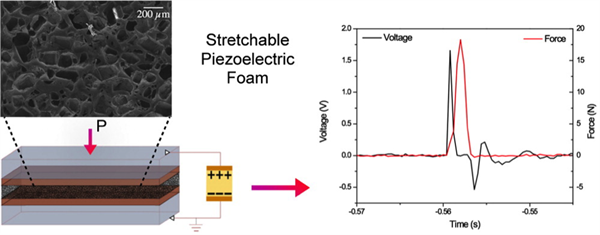(SD2015-105) Piezoelectric Nanoparticle-Polymer Composite Foams
Background
Mechanically flexible piezoelectric materials are highly sought after when building advanced sensors, actuators, and energy scavenger devices. The most common piezoelectric materials used in applications are focused on electroceramic thin films made from lead zirconate titanate or barium titanate. Although these materials can have large piezoelectric moduli, as thin films they are extremely brittle and difficult to shape into highly mechanically compliant structures. Improving mechanical flexibility of piezoelectrics, and creating higher order structures, is critical for driving new applications such as biological energy harvesting, compact acoustic transducers, and in vivo biodiagnostics. There is a need to develop alternative materials that offer high piezoelectric coefficients while maintaining elasticity and isotropic mechanical integrity—that are also cheap to produce.
Technology Description
Researchers from UC San Diego have now patented a process to create highly elastic piezoelectric polymers that maintain 3D structural isotropy (properties of a material are the same in all directions) and strong piezoelectric behavior. This technology leverages a piezoelectric nanoparticle-polymer composite blend that can be cheaply and easily processed into a variety of shapes. The final material is extremely light and stretchable while retaining excellent piezoelectric properties.

State Of Development
Power studies indicated that these materials can operate under mechanical loads and have enough power to drive low power devices. Given the tunable porosity, mechanical flexibility of the foams, high surface area, high piezoelectric sensitivity, isotropic microstructure, and more biocompatible chemical makeup compared to bulk electroceramics, these foams should find immediate applications in energy scavenging platforms, biosensors, and acoustic transducers. Patent rights are available for licensing in the USA.
Techniques, systems , and devices are disclosed for implementing fabrication of stretchable nanoparticle-polymer composite structures, such as foams that exhibit piezoelectric properties. The mechanical and electrical properties of the material can be tuned based on the level of porosity introduced as well as compositional variations such as loading fractions of nanoparticles. The disclosed stretchable nanoparticle-polymer composite structures that exhibit piezoelectric properties can have various applicationsincluding high resolution, compact ultrasonic imaging instruments; acoustic sensors; chemical sensors; mechanical actuators; biodiagnostic materials (e.g ., microfluidics , small molecule force sensing); remote interfacing (e.g., acoustic detection) with portable electronics ; and energy scavenging.
Related Materials
Patent Status
| Country | Type | Number | Dated | Case |
| United States Of America | Issued Patent | 10,199,560 | 02/05/2019 | 2015-105 |
Additional Patents Pending
Contact
- Skip Cynar
- scynar@ucsd.edu
- tel: View Phone Number.
